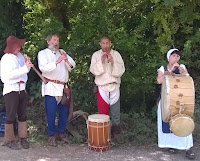As the days grew shorter, darker and colder,
we decided we would make one last trip away from home before settling down to
Christmas and the New Year. Regular readers of this blog will know Rye in
Sussex is a special destination for us and so, in November, we revisited the magical medieval
town perched on a hill in time to witness its famous bonfire night. Dating back several hundred years, ‘Rye
Fawkes’ night predates the gunpowder plot and features not only the bonfire and
fireworks associated with bonfire nights all over the UK but
also burning boats, fire-breathing dragons and a spectacular procession of
flaming torches through the town's streets. Its history is obscure
but it seems to be less about Guy Fawkes & Co. and more about a curious
mixture of disguise, revelry, smugglers, warding off the threat of invasion and
ancient end-of-year traditions of banishing evil with flaming torches.
 |
| The 2014 edition of Rye Royal |
The pageant of Rye bonfire provided the
backdrop to Malcolm Saville's 1969 book Rye
Royal. When the book was republished in 2014 (by Girls Gone By Publishers) I
was privileged and delighted to be asked to write an introduction for the new
edition. Of course, it is to the children's adventures of Saville that I owe my
fascination with Rye and the surrounding area so it seemed appropriate that we should
make the short journey from Rye to neighbouring Winchelsea, where Saville lived
throughout the 1970s. He died in 1982 and his ashes are buried in the Garden of
Remembrance at Winchelsea church (the Church of St Thomas.) We chatted with a
local resident at the gates of the churchyard who said he knew Saville had lived
in the town but didn't realise his ashes were buried there. He did, however,
point out the grave of another famous former resident of Rye – Spike
Milligan. The already rather worn tombstone
of Milligan (who died in 2002) famously bears the Irish epitaph "Dúirt mé leat go raibh mé breoite"
("I told you I was ill") – a last joke by the comedian.
I can remember a day, when I was at primary
school, when the teacher read us some poetry by Spike Milligan. I was completely captivated by lines such as:
"On the Ning Nang Nong
Where the Cows go Bong!
and the monkeys all say BOO!
There's a Nong Nang Ning
Where the trees go Ping!
And the teapots jibber jabber joo."
I raved about these poems to my sister Jan (who happened
to work at Wildings bookshop in Shrewsbury) and she came home with a gift for
me: a yellow paperback copy of Milligan's
Silly Verse for Kids. I read and
memorised some of the poems, like Bongaloo:
"How strange is a Bongaloo,
Daddy?"
"As strange as strange," I
replied.
"When the sun's in the West
It appears in a vest
Sailing out with the noonday tide."
It may have been nonsense but it was poetry.
Just as Saville's novels would later make me yearn for adventure, travel and loyal
friendships (not to mention fostering a love of books and a desire to be an
author) so Milligan's verse (with its wit, perfect rhythm, alliteration and assonance)
was surely an excellent foundation for an aspiring songwriter with an appreciation
of the surreal and the absurd. Strange,
then, that these two writers, so influential to me, should both be laid to rest
in the grounds of the same church in Winchelsea.
Part of the charm of the sister towns of Rye and Winchelsea is that they are both a little lost in time. Some things have
changed, though, since our last visit. The windmill where we stayed has new
owners and, in Lion Street, buildings that were once a Victorian schoolhouse (and later a library) now house a wonderful state-of-the-art cinema – the Kino Rye. It's surely a hopeful sign that
places can celebrate their long history and ancient traditions and still
develop beautiful new venues for arts and entertainment. I'd like to think both Saville and Milligan
would approve.
Saville, in his Portrait of
Rye, wrote:
 "It
is difficult to assess the magnetism of this historic little town. I have come
to believe that in this unhappy age
of standardization and mediocrity, Rye stands alone, sufficient to itself. It is not indifferent to the outside
world but history has left its mark."
"It
is difficult to assess the magnetism of this historic little town. I have come
to believe that in this unhappy age
of standardization and mediocrity, Rye stands alone, sufficient to itself. It is not indifferent to the outside
world but history has left its mark."
Milligan, in his book Puckoon, wrote:
“Life wasn't too bad. The trouble
with Man was, even while he was having a good time, he didn't appreciate it. Why, thought Milligan, this very moment
might be the happiest in me life. The
very thought of it made him miserable.”
Happy New Year!




























